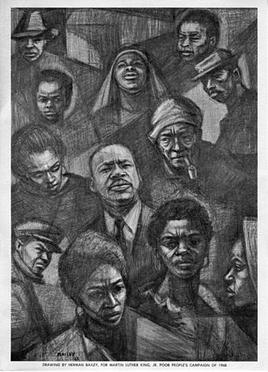Herman Bailey facts for kids
Quick facts for kids
Herman "Kofi" Bailey
|
|
|---|---|

Bailey's signature
|
|
| Born |
Herman Bailey
November 28, 1931 |
| Died | April 27, 1981 (aged 49) |
| Nationality | American |
| Education | Alabama State College, University of Southern California |
| Movement | Pan-Africanism |
| Patron(s) | Maya Angelou, James Early, Samella Lewis |
Herman "Kofi" Bailey (also known as Kofi X) (1931–1981) was an African-American artist. He was famous for his drawings using conté crayon and charcoal. His art often showed the experiences of African-American people.
Contents
About Kofi Bailey's Life
Kofi Bailey was born in Chicago, Illinois. He grew up in Los Angeles, California. He went to college at Alabama State College. Later, he studied at Howard University. There, he learned from important thinkers like Alain Locke and Sterling Brown. He earned his advanced art degree (MFA) from the University of Southern California.
While he was a student at Alabama, he was asked to create large paintings and murals. He lived in Atlanta for a time. His art studio was at the Institute of the Black World. He sometimes traded his artwork to pay for his hotel room. Kofi Bailey passed away in 1981 in Atlanta, Georgia.
Kofi Bailey's Art Career
Kofi Bailey's artwork often mixed shapes and figures. He used big, bold shapes around the main people in his drawings. These figures were usually the most important part of his art. He often used charcoal or conté crayon. Sometimes he also tried oil and acrylic painting. He liked to use natural, earthy colors in his art.
Bailey was inspired by other artists. Some of these included Goya, Rico Lebrun, Jacob Lawrence, and Charles White. In 1967, he said he was a "representational" artist. This means his art showed real things, not just abstract shapes. He felt his art should connect with people. He wanted his art to show the many feelings of humans.
From 1962 to 1966, Kofi Bailey lived in Ghana. He worked there as an art teacher. He was also an artist-in-residence for Ghana's leader, Kwame Nkrumah. In 1967, Spelman College held an art show. It featured the artwork Bailey made while he was in Ghana.
Art and Social Messages
Kofi Bailey's art often showed ideas from Pan-Africanism. This is a movement that supports the unity of all African people. He often drew portraits of Kwame Nkrumah. He showed Nkrumah as a hero. Bailey's art also explored other parts of the African-American experience. This included themes like Black Power and fighting against colonialism. He also supported African-American civil rights.
His art often featured Black women and children. These artworks showed the racism faced by Africans and African Americans. This was especially true in the 20th century. The strong contrast of black charcoal on white paper often highlighted these struggles. His work is often seen in books and art about the Civil Rights Movement.
While living in Atlanta, he created posters for the H. Rap Brown Center. This was a place where members of the Student Nonviolent Coordinating Committee (SNCC) often met. He later made posters and drew pictures for SNCC's newsletter. Bailey created art that supported the freedom struggles of African Americans and Arab people.
Notable Art Collections
Kofi Bailey's artwork can be found in many important collections, including:
- California African American Museum
- Hampton University
- National Museum of African American History and Culture
- National Civil Rights Museum
- Spelman College
- University Museums at the University of Delaware
Notable Art Exhibitions
Kofi Bailey's art has been shown in many exhibitions, such as:
- Showcase & Tell: Treasures from the Spelman College Permanent Collection, 2009, Spelman College, Atlanta
- Tradition Redefined: The Larry and Brenda Thompson Collection of African American Art, 2009, University of Maryland, College Park
- A Century of African American Art: The Paul R. Jones Collection, 2004, University of Delaware, Newark
- Atlanta Collects, 2004, City Gallery East, Atlanta
- Black Power/Black Art: and the struggle continues: Political Imagery from the Black Arts Movement of the 1960s and 1970s, 1994, San Francisco State University, San Francisco
- African American Art in Atlanta: Public and Corporate Collections, 1984, High Museum of Art, Atlanta
- A Memorial Exhibition, 1982, Spelman College, Atlanta
- Highlights from the Atlanta University Collection of Afro-American Art, 1973, High Museum of Art, Atlanta
- TCB, 1971, National Center of Afro-American Artists, Boston


